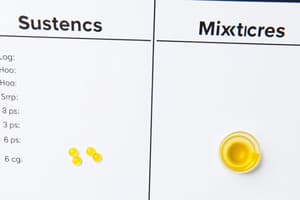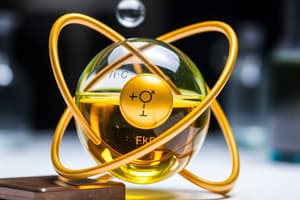Podcast
Questions and Answers
What should candidates ensure before they start answering questions on the paper?
What should candidates ensure before they start answering questions on the paper?
- That they leave some pages blank
- That their roll number is in the answer-book
- That the question paper is correct and complete (correct)
- That they have their answer-book ready
How many printed pages should the question paper contain?
How many printed pages should the question paper contain?
- 13 (correct)
- 15
- 10
- 20
What action must be taken before answering a question according to the instructions?
What action must be taken before answering a question according to the instructions?
- Write the question's Serial Number (correct)
- Draw diagrams wherever necessary
- Underline the key concepts
What will happen if a candidate makes a claim about the question paper after the examination?
What will happen if a candidate makes a claim about the question paper after the examination?
What should candidates do if they require additional space for their answers?
What should candidates do if they require additional space for their answers?
What must candidates write on the question paper?
What must candidates write on the question paper?
How many questions does the question paper have?
How many questions does the question paper have?
What instruction is given regarding blank pages in the answer-book?
What instruction is given regarding blank pages in the answer-book?
How many total questions are present in the paper?
How many total questions are present in the paper?
What type of questions does Section A consist of?
What type of questions does Section A consist of?
What is the mark distribution for questions in Section C?
What is the mark distribution for questions in Section C?
Which section contains internal choice questions?
Which section contains internal choice questions?
Which segment of the question paper includes two marks questions?
Which segment of the question paper includes two marks questions?
For how many questions does each answer from (vi) to (xiv) allow one or two-word responses?
For how many questions does each answer from (vi) to (xiv) allow one or two-word responses?
What is the maximum mark allotted for each question in Section D?
What is the maximum mark allotted for each question in Section D?
How many sections is the paper divided into?
How many sections is the paper divided into?
Which type of questions are included in Section B of the question paper?
Which type of questions are included in Section B of the question paper?
Which of the following is not a section in the question paper?
Which of the following is not a section in the question paper?
What is the boiling point of water when 18 g of glucose is dissolved in 1 kg of water at 1.013 bar?
What is the boiling point of water when 18 g of glucose is dissolved in 1 kg of water at 1.013 bar?
How long will it take for a first order reaction with a rate constant of 1.15 × 10-3 s-1 to reduce 5 g of reactant to 3 g?
How long will it take for a first order reaction with a rate constant of 1.15 × 10-3 s-1 to reduce 5 g of reactant to 3 g?
According to Faraday’s first law of electrolysis, what is directly proportional to the amount of substance deposited?
According to Faraday’s first law of electrolysis, what is directly proportional to the amount of substance deposited?
What defines the Wurtz reaction?
What defines the Wurtz reaction?
Lanthanoid contraction primarily affects which of the following properties of elements?
Lanthanoid contraction primarily affects which of the following properties of elements?
What is the main reason phenol is more acidic than alcohol?
What is the main reason phenol is more acidic than alcohol?
Which statement correctly describes a characteristic of a facial isomer?
Which statement correctly describes a characteristic of a facial isomer?
Which method is appropriate for identifying primary amines?
Which method is appropriate for identifying primary amines?
What is the result of the Swarts reaction?
What is the result of the Swarts reaction?
What characterizes a pseudo first order reaction?
What characterizes a pseudo first order reaction?
Why are haloarenes resistant to nucleophilic substitution?
Why are haloarenes resistant to nucleophilic substitution?
Which acid from the pair CH3COOH and CH2FCOOH is expected to be stronger?
Which acid from the pair CH3COOH and CH2FCOOH is expected to be stronger?
What defines osmotic pressure?
What defines osmotic pressure?
What is the IUPAC name of [Co(NH3)6]Cl?
What is the IUPAC name of [Co(NH3)6]Cl?
Why does the pK of aniline exceed that of methylamine?
Why does the pK of aniline exceed that of methylamine?
Which vitamins are classified as fat-soluble?
Which vitamins are classified as fat-soluble?
What is the primary reason for the stability of Mn2+ compounds compared to Fe2+ in higher oxidation states?
What is the primary reason for the stability of Mn2+ compounds compared to Fe2+ in higher oxidation states?
Which characteristic best explains a peptide linkage?
Which characteristic best explains a peptide linkage?
How would one apply Henry's law practically?
How would one apply Henry's law practically?
What is the product when Benzoic acid is converted to m-Nitrobenzyl alcohol?
What is the product when Benzoic acid is converted to m-Nitrobenzyl alcohol?
What is the correct reaction product for the conversion of Benzaldehyde to Benzophenone?
What is the correct reaction product for the conversion of Benzaldehyde to Benzophenone?
Which process describes the reaction involving the formation of an enolate from a carbonyl compound followed by a reaction with another carbonyl compound?
Which process describes the reaction involving the formation of an enolate from a carbonyl compound followed by a reaction with another carbonyl compound?
What is the outcome of the given reaction: $C_2H_5OH + CH_3COCl \rightarrow$?
What is the outcome of the given reaction: $C_2H_5OH + CH_3COCl \rightarrow$?
Which statement correctly describes the Nernst equation?
Which statement correctly describes the Nernst equation?
What does the standard cell potential represent in an electrochemical cell?
What does the standard cell potential represent in an electrochemical cell?
For the reaction $Zn + 2Ag^+ \rightarrow Zn^{2+} + 2Ag$, what is the standard cell potential calculated?
For the reaction $Zn + 2Ag^+ \rightarrow Zn^{2+} + 2Ag$, what is the standard cell potential calculated?
What defines the working principle of the standard hydrogen electrode?
What defines the working principle of the standard hydrogen electrode?
When 0.5 amperes of current flows through a wire for 2 hours, how many electrons flow through it?
When 0.5 amperes of current flows through a wire for 2 hours, how many electrons flow through it?
Which of the following does NOT describe decarboxylation?
Which of the following does NOT describe decarboxylation?
Flashcards are hidden until you start studying
Study Notes
Exam Overview
- The exam is for 12th grade students, specifically in Chemistry.
- Total duration is 3 hours and the maximum score is 70 marks.
- It consists of 20 questions divided into four sections: A, B, C, and D.
General Instructions
- All questions are compulsory.
- The question paper has a total of 20 questions organized into four sections with different types of questions.
- Section A includes 15 objective type questions with various formats, including multiple-choice.
- Sections B, C, and D contain very short, short, and long answer type questions respectively.
- Ensure correct and complete question paper before starting; no claims will be entertained afterward.
Section A - Objective Type Questions
- Question Format: 1 mark each for multiple-choice and one or two-word answers.
- Topics: Questions may include definitions, reactions, and laws related to Chemistry concepts.
- Example questions could cover definitions (e.g., "What is pseudo first order reaction?") and applications of laws (e.g., "One application of Henry’s law").
Section B - Very Short Answer Type Questions
- Question Format: 2 marks each.
- Topics typically involve explanations of concepts like nucleophilic substitution and strength comparison of acids.
- Questions may ask students to provide IUPAC names for given compounds or to explain observations about chemical properties (e.g., why aniline has a higher pK than methylamine).
Section C - Short Answer Type Questions
- Question Format: 3 marks each.
- Focus on applied concepts and calculations, such as changes in boiling point due to solutes and determining time taken for reactions.
- Questions may require elaboration on specific chemical reactions or phenomena, such as Faraday's laws or identifying functional groups.
Section D - Long Answer Type Questions
- Question Format: 5 marks each.
- Emphasis on detailed explanations and chemical equations.
- Students could be asked to perform conversions between different organic compounds, describe reaction mechanisms, or derive important equations like Nernst's equation.
- May involve drawing structural representations or explaining concepts such as lanthanoid contraction and its effects.
Key Topics Covered
- Chemical Reaction Types: Understanding pseudo first-order reactions, nucleophilic substitutions, and electrolysis.
- Organic Chemistry: Reactions like Wurtz, Sandmeyer, and Aldol condensation; identification of amines and acids.
- Inorganic Chemistry: IUPAC naming conventions and structural isomers.
- Physical Chemistry: Concepts including osmotic pressure as a colligative property and Nernst equation for electrochemical cells.
Practical Applications
- Understanding real-world applications of chemical laws and principles in experimental and theoretical scenarios.
- Evaluating the stability of compounds and predicting outcomes based on structural differences.
- Conducting stoichiometric calculations to gauge reaction progress and yields.
Tips for Preparation
- Review definitions and key concepts in organic, inorganic, and physical chemistry.
- Practice writing and balancing reactions.
- Familiarize with chemical equations and their implications.
- Solve past paper questions to understand exam format and expectations.
Studying That Suits You
Use AI to generate personalized quizzes and flashcards to suit your learning preferences.




